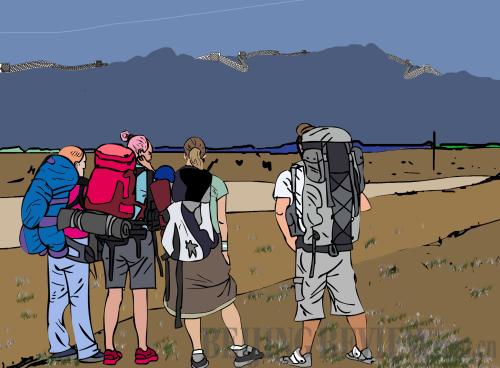|
 |
|
(LI SHIGONG) |
To grasp the length of the Great Wall, one must travel on the Silk Road across the Gobi Desert. Our group of international East West Center scholars is ready.
First our tour group hikes a piece of the Beijing section of the Great Wall. Built in the fifth century B.C. and maintained until the 16th Century, the wall was constructed here on murderous mountainous terrain. We picture the dry bones of generations of builders buried beneath the stone. Today, however, the wall is crowded with sophisticated Chinese tourists, orange clad monks, and enthusiastic students.
I linger on a landing to draw a sketch. I am a retired teacher and student of Chinese brush. I use university Mandarin to give people permission to take my photo with their children. Some rural kids are afraid of me but I explain, "I'm a teacher. Don't be scared. You look like my granddaughter." They usually do not smile.
As we leave Beijing on Air China, a melancholy comes: I can use Mandarin in Beijing since this national language is similar to Beijing dialect. What will happen in the far west in Urumqi, capital city of Xinjiang Uygur Autonomous Region? We are flying low and slowly. I can view arid desert as frosted mountains stand guard. The Uygur ethnic group mainly lives here. The Uygur people have their own language related to Turkish with roots in Muslim culture.
Historically, the Silk Road trade depended on camel caravans that crossed vast pasture lands of the Steppes of Mongolia, or the Alti Mountains, Hexi Corridor, and Tibetan Plateau; no settlements were seen unless there was an oasis or underground, man-made canals.
I do a little lap-sized painting of blue-grey mountains towering over black and gold dunes that look like the taiji symbol: One side of the dunes or mountains is lit by sunlight, while the opposite side is as black as Chinese ink.
Suddenly, after vistas of sandy basins and gorges, I spot an unusual formation in the middle of the desert. There is a man-made raised, square-like pattern with four triangles around the periphery. These triangles appear to be elevated. Each triangle points in the four directions. My airplane seatmate snores. Quickly I draw a sketch of the patterns. What could it be? I have seen no buildings. No people. No roads. No sign of life—at least, on my side of the airplane. What is on the other side of the plane? My imagination kicks in: A nuclear facility? A sacred place? An airport? What?
A few minutes later, I see two more of these patterns almost identical to the first one.
Then, empty desert. I pop out of my seat. "What are these formations outside?" I show my art sketchbook.
"I don't know what that is," says the Chinese flight attendant.
Filled with curiosity, we land at the airport of Urumqi. Our new tour guide looks as if his ancestors were from the Middle East. He has a large nose, black round eyes, olive skin and a spontaneous grin.
"Do you speak Mandarin?" I ask in Mandarin.
"I can!" He does a double take of my 65-year-old face.
"It is thrilling to have a minority guide," I whisper when I get back to my seat. "The Chinese Government has done a good job of teaching Mandarin in the western region!"
Now I show him the formations in my art sketchbook. "Oh, I don't know what it is!" he says apologetically. "Maybe the Great Wall."
"The Great Wall?" I say. "This far out?"
A week later our group arrives in the ancient capital of Xi'an. William, our new tour guide, says he is a Tibetan with a master's degree in anthropology of ancient China. As time permits, I show William my sketch of the odd formations that I had seen on the airplane. "Oh, yes," he smiles confidently. "Those are watchtower bases from the ancient Great Wall. Maybe the barracks are above. This is probably the base of the gate tower," he says.
It is one thing to hike up the Great Wall in Beijing surrounded by greenery. It is quite another to fly over it a thousand miles away from Beijing. We now learn that an emperor ordered another part of the Great Wall in this inhospitable, barren Gobi Desert.
There are at least five major sections of the Great Wall, says William, pointing to a map in the sensational Ancient History Museum of Xi'an. Here we also view ancient mummies wearing Roman silk. Proof of Silk Road trade is on display.
After our journey on the Silk Road, my sense of space and geography have expanded: As the vast Pacific Ocean linking the shores of San Francisco and Shanghai shrinks due to air travel, our beloved United States feels younger, and China's Gobi Great Wall formations are a clear voice from China's ancestral past.
The author is an American who has lived in China
Email us at: zanjifang@bjreview.com | 